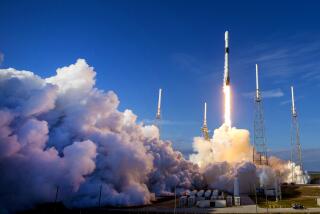40 years later, recalling the lessons of Apollo 1
- Share via
CAPE CANAVERAL, FLA. — Forty years after three Apollo astronauts died in a launch-pad training exercise, the tragedy’s pivotal role in the Space Age never has been clearer.
Some of the 200 family members, former astronauts and well-wishers who attended a remembrance ceremony Saturday emphasized that point while paying homage to the lives of Virgil “Gus” Grissom, Ed White and Roger Chaffee.
The event marking the 40th anniversary of the Apollo 1 fire took place in front of the Space Mirror Memorial at the Kennedy Space Center Visitor Complex.
As the U.S. prepares to return to the moon in the next decade, NASA’s leaders stressed the need to stay mindful of the lessons of Apollo 1.
“What we really learned from the Apollo fire, in the words of [former astronaut] Frank Borman, was the failure of imagination,” said William H. Gerstenmaier, NASA’s associate administrator for space operations. “We couldn’t imagine a simple test on the pad being that catastrophic.
“The message to the team is to remember how difficult our business is, the importance of staying focused and using our imaginations to envision what can go wrong.”
The men who died in the accident were three of NASA’s best and brightest: Grissom, the second American in space and one of NASA’s most veteran astronauts; White, a West Point graduate who was the first American spacewalker; and Chaffee, a rookie astronaut considered one of the agency’s most talented engineers.
Grissom’s brother, Lowell, still remembers the phone call that day from his father. “It was a total shock because we never expected anything to happen on the ground,” he said. “You kind of prepare yourself for something like that happening in space.”
After the event at Kennedy Space Center, Lowell Grissom and other family members held a private evening ceremony a few miles away at the scene of the accident: Cape Canaveral Air Force Station’s long-abandoned Launch Complex 34.
Today, the site is a desolate spot, where a giant concrete launch platform remains amid rusting metal, tall grass and swirling ocean breezes. Two plaques honoring the fallen astronauts are attached to the platform. One bears the inscription “Ad Astra Per Aspera” (A Rough Road Leads to the Stars).
A fateful Friday
Launch Complex 34 and the rest of America were very different on Jan. 27, 1967.
The U.S. military was wrapping up Operation Cedar Falls, the biggest American offensive to that point in the Vietnam War. And twelve days earlier was the first Super Bowl.
Complex 34’s seaside launch pad was a beehive of activity on that fateful Friday afternoon as NASA raced against the calendar to land a man on the moon before the end of the decade. Less than four weeks remained until the target launch date of what was then called Apollo/Saturn 204 -- a two-week mission in Earth’s orbit that would be the first manned test flight of the new Apollo command module.
The day’s activities centered on a “plugs out” test, where the command module would go through a simulated countdown disconnected from external cables and using the capsule’s internal systems. Grissom, White and Chaffee boarded their spacecraft shortly after 1 p.m., but a series of technical issues caused hours of delays.
Flight controllers still were troubleshooting a communications problem at 6:31 p.m., when a brief transmission, believed to be from Chaffee, reported, “We’ve got a fire in the cockpit.” Seven seconds later, a second, garbled transmission contained the phrases “bad fire” and “get out.” With that, the crew went silent.
About a minute later, the ground crew began fighting the fire and working to open the capsule’s hatches as smoke billowed from the spacecraft. It took five minutes to get inside the scorched interior, where it immediately became clear the three astronauts had perished. Doctors determined the crew probably died quickly from smoke inhalation.
“We knew NASA was under pressure,” recalled Apollo 7 astronaut Walter Cunningham, a backup crew member for the mission who had been in the capsule for a test the previous night. “We knew the spacecraft was not as good as it should be, but we were egotistical enough to think we could fly it anyway.”
Important changes
An accident review board later concluded the pressurized, highly combustible pure-oxygen environment inside the capsule led to the interior being set ablaze by an electrical arc from wiring. The high pressure inside also prevented the crew from opening the hatches.
Important changes resulted from the accident. The Apollo command module underwent a major 18-month redesign and later supported six lunar landings with only minor problems.
Four decades later, Apollo veterans take solace in the fact their comrades didn’t die in vain. The accident paved the way for NASA’s crowning achievement: accomplishing President Kennedy’s goal of a manned mission to the moon by the end of the 1960s.
“If we had not had the Apollo fire, we would never have gotten to the moon,” said John Young who walked on the moon during the Apollo 16 mission. “The fire enabled us to get to the moon because then we went back and fixed the spacecraft right.... It was a real lesson.”
More to Read
Sign up for Essential California
The most important California stories and recommendations in your inbox every morning.
You may occasionally receive promotional content from the Los Angeles Times.










